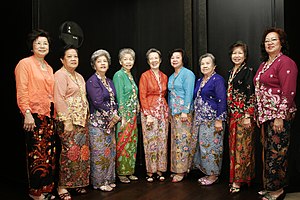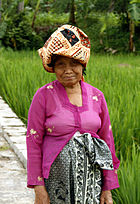A group of women posing in traditional Peranakan nonya kebaya
The kebaya is the national costume of Indonesia, although it is more accurately endemic to the Javanese, Sundanese and Balinese[1] peoples.
Etymology
Kebaya is inspired from Arab region clothing;[2] the Arabic word abaya means clothing.History

R.A. Kartini and her husband in 19th century
The name of Kebaya as a particular clothing type was noted by the Portuguese when they landed in Indonesia. Kebaya is associated with a type of blouse worn by Indonesian women in 15th or 16th century. Prior to 1600, kebaya on Java island were considered as a sacred clothing to be worn only by royal family, aristocrats (bangsawan) and minor nobility, in an era when peasant men and many women walked publicly bare-chested.
Slowly it naturally spread to neighbouring areas through trade, diplomacy and social interactions to Malacca, Bali, Sumatra, Borneo, Sulawesi and the Sultanate of Sulu and Mindanao [4][5][6] Javanese kebaya as known today were noted by Raffles in 1817, as being of silk, brocade and velvet, with the central opening of the blouse fastened by brooches, rather than button and button-holes over the torso wrap kemben, the kain (and unstitched wrap fabric several metres long erroneously termed 'sarong in English (a sarung (Malaysian accent: sarong) is stitched to form a tube, like a Western dress) After hundreds of years of regional acculturation, the garments have become highly localised expressions of ethnic culture, artistry and tailoring traditions.
The earliest photographic evidence of the kebaya as known today date from 1857 of Javanese, Peranakan and Eurasian styles.[7]
Costume components
The blouse is commonly semi-transparent and worn over the torso wrap or kemben. The skirt or kain is an unstitched fabric wrap around three metres long. The term sarong in English is erroneous, the sarung (Malaysian accent: sarong) is actually stitched together to form a tube, like a Western dress- the kain is unstitched, requires a helper to dress (literally wrap) the wearer and is held in place with a string (tali), then folded this string at the waist, then held with a belt (sabuk or ikat pinggang), which may hold a decorative pocket.
Varieties
There are two main varieties. The blouse, known as baju kebaya may be of two main form: the semi-transparent straighter cut blouse of the Java, Bali, the more tightly tailored Sunda kebaya, and the more Islamic compatible, plainer baju kurung is a loose-fitting, knee-length long-sleeved blouse worn in the more adherent Muslim areas- including former Kingdom of Johor-Riau (now Malaysia), Sumatra and parts of coastal Java.In Java, Bali and Sunda, the kain is commonly batik which may be from plain stamped cotton to elaborately hand-painted batik tulis embroidered silk with gold thread. In Lampung, the kain is the traditional tapis- an elaborate gold-thread embroidered ikat with small mica discs.[10] Sumatera, Flores, Lemata Timor, and other islands commonly use kain of ikat or songket. Sumba is famous for kain decorated with lau hada: shells and beads.[11]
In the Malacca, Malaysia, a different variety of kebaya is called "nyonya kebaya" worn by those of Chinese ancestry: the Peranakan people. The Nyonya kebaya is different in its famously intricately hand-beaded shoes (kasut manek) and use of kain with Chinese motive batik or imported printed or hand-painted Chinese silks. Other than Malacca, the nyonya kebaya also popular in other straits settlements; Penang and Singapore.
In Java, the kebaya worn by ladies of Chinese ancestry is called kebaya encim, derived from the name encim or enci to refer to a married Chinese woman.[12] It was commonly wore by Chinese ladies in Javan coastal cities with significant Chinese settlements, such as Semarang, Lasem, Tuban, Surabaya, Pekalongan and Cirebon. It marked differently from Javanese kebaya with its smaller and finer embroidery, lighter fabrics and more vibrant colors, made from imported materials such as silk and other fine fabrics. The encim kebaya fit well with vibrant-colored kain batik pesisiran (Javan coastal batik).
During Dutch colonization of the island, European women began wearing the less restrictive and cooler kebaya as a formal or social dress. European women wore shorter sleeve and total length cotton in prints.
The day kebaya of the Indo Eurasians was of white cotton trimmed with European handmade lace- commonly from Bruges or the Netherlands and black silk for evening wear.
Political significance
The only woman present during Indonesia's Proclamation of Independence, Dutch-educated activist SK Trimurti- wore kebaya cementing it as the female dress of Nationalism.In Japanese internment camps during the Second World War, Indonesian female prisoners refused to wear the Western dress allocated them and instead wore kebaya as a display of Nationalist and racial solidarity separate from fellow Chinese, Europeans and Eurasian inmates.[13]
The 21st of April is celebrated in Indonesia as National Kartini Day where Raden Ajeng Kartini, the female suffragist and education advocate is remembered by schoolgirls wearing traditional dress according to their region. In Java, Bali and Sunda it is the kebaya.[1]
Kebaya as the national costume of Indonesian women were often featured by Indonesian first ladies. The wives of Sukarno, Indonesian first president; Fatmawati Sukarno and Dewi Sukarno were known to wearing kebaya daily.
The Suharto-era bureaucrat wives' social organisation Dharma Wanita wears a uniform of gold kebaya, with a red sash (selendang) and stamped batik pattern on the kain unique to Dharma Wanita. The late Indonesian first lady and also a minor aristocrat Tien Suharto was a prominent advocate of the kebaya.
Former President Megawati Sukarnoputri is a public champion of kebaya and wears fine red kebaya whenever possible in public forums and 2009 Presidential election debates.
Cultural rivalry between Malaysia and Indonesia has given rise to media-based spats over the true ownership of the 'kebaya.
Modern usage and innovations
Apart from traditional kebaya, fashion designers are looking into ways of modifying the design and making kebaya a more fashionable outfit. Casual designed kebaya can even be worn with jeans or skirts. For weddings or formal events, many designers are exploring other types of fine fabrics like laces to create a bridal kebaya.Modern-day kebaya now incorporate modern Western tailoring innovations such as clasps, zippers and buttons- zippers being a much appreciated addition for ladies' requiring the bathroom, without requiring being literally unwrapped by a helper- to the extent the true kain is near unanimously rejected. Other modern innovations have included the blouse baju kebaya worn without the restrictive kemben, and eve the kebaya blouse worn with slacks or made of the fabric usually for the kain panjang. The female flight attendant of Malaysia Airlines also featuring batik kebaya as their uniform.
The female uniform of Garuda Indonesia flight attendants is more authentic modern interpretations, the kebaya is designed in simple yet classic kartini style kebaya derived from 19th century kebaya of Javanese noblewomen. The kebaya made from fire-proof cotton-polyester fabrics, with batik sarongs in parang or lereng gondosuli motif, which also incorporate garuda's wing motif and small dots represent jasmine.[14]
Gallery
-
European child with sarong and kebaya, the Tropenmuseum collection
References
- ^ a b Jill Forshee, Culture and customs of Indonesia, Greenwood Publishing Group: 2006: ISBN 0313333394: 237 pages
- ^ Denys Lombard (1990) (in French). Le carrefour javanais: Essai dhistoire globale (Civilisations et sociétés). École des hautes études en sciences sociales. ISBN 2-7132-0949-8.
- ^ Maenmas Chavalit, Maneepin Phromsuthirak: Costumes in ASEAN: ASEAN Committee on Culture and Information: 2000: ISBN 974-7102-83-8: 293 pages
- ^ S A. Niessen, Ann Marie Leshkowich, Carla Jones: Re-orienting fashion: the globalization of Asian dress Berg Publishers: 2003: ISBN 1-85973-539-8, ISBN 978-1-85973-539-8, 283 pages pp 206-207
- ^ Cattoni Reading The Kebaya paper was presented to the 15th Biennial Conference of the Asian Studies Association of Australia in Canberra 29 June-2 July 2004.
- ^ Michael Hitchock Indonesian Textiles: Harper Collins 1991
- ^ Maenmas Chavalit, Maneepin Phromsuthirak: Costumes in ASEAN: ASEAN Committee on Culture and Information: 2000: ISBN 974-7102-83-8: 293 pages
- ^ Panular, P. B. R. Carey, The British in Java, 1811-1816: a Javanese account : a text edition, English synopsis and commentary on British Library Additional Manuscript 12330 (Babad Bĕdhah ing Ngayogyakarta), British Academy by Oxford University Press: 1992, ISBN 0-19-726062-4: 611 pages
- ^ John Pemberton, On the subject of "Java"', Cornell University Press: 1994, ISBN 0-8014-9963-1: 333 pages
- ^ Inger Mcabe Elliott Batik: Fabled Cloth of Java, Hong Kong Periplus: 2004
- ^ Mattiebelle Gittinger, To Speak with Cloth:Studies in Indonesian textiles University of California: 1989
- ^ Agnes Swetta Pandia and Nina Susilo (13 January 2013). "Tantangan Bisnis Kebaya Encim" (in Indonesian). Female Kompas.com. Retrieved 19 January 2013.
- ^ Cattoni Reading The Kebaya paper was presented to the 15th Biennial Conference of the Asian Studies Association of Australia in Canberra 29 June-2 July 2004: 8
- ^ Kompas Female Terbang Bersama Kebaya







Tidak ada komentar:
Posting Komentar